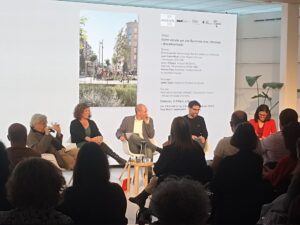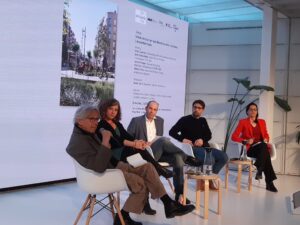Last night the Professional Association of Architects in Catalonia (COAC – Col.legi d’Arquitectes de Catalunya) hosted a round table with leading experts on transportation policy: Silvia Casorrán, Javier Ortigosa (AMB), and Barbara Pons (Barcelona Regional). It was a pleasure to join this well-respected panel to exchange views on what needs to be done to decarbonize our transportation system. In this blog post I would like to summarize the key ideas that I put forward in the debate, and capture some of the general themes of the conversation.
The event had the provocative title We want to circulate in a clean, silent and de-carbonized Barcelona and panelists were asked to explain the challenges they see in Barcelona’s transportation system and put forward new ideas on what should be done.
I argued that we are in a climate emergency; that the high quality of life we enjoy in Barcelona today is not guaranteed in the future; and that to protect our wellbeing, health and economy, we need more ambitious and profound changes to our mobility system with massive investments in active travel infrastructure. Barcelona will be confronting summer temperatures of 45° C, with serious human health and economic consequences. In this context of our climate crisis, we are not seeing the ambition and leadership that we need to decarbonize our transportation system.
In short, Barcelona is missing political leadership for the profound transformation that we need.
I proposed four specific policy actions that should be prioritized. (ie. What is Barcelona is missing?)
- A congestion charge
This is a proven policy intervention that has been successfully implemented in cities around the world. Congestion charging in London began over 20 years ago (2003) and has reduced NOx by 17% and particulate matter by 4%.
The most complete congestion charge proposal to date for Barcelona has been put forward by a coalition of local groups, associations and non-profit organizations* (www.barcelona22.net). Barcelona’s Low Emissions Zone has created the technical system and technology, with cameras, and legal framework in order to move ahead with the congestion charge. Right now, we are simply missing the political will.
*Plataforma per la Qualitat de l’Aire (PQA), Associació per a la Promoció del Transport Públic (PTP), Ecologistes en Acció de Catalunya, Eixample Respira, Bicicleta Club de Catalunya (BACC), Xarxa per la Justícia Climàtica, Catalunya Camina, Associació de Prevenció d’Accidents de Trànsit.
- A regional bicycle network
Thanks to the work by the AMB, there has been great progress in creating a regional bicycle network. But the true value of the network will be realized once the connections are complete and there are no missing links. Completing the network would bring major gains in active travel, improved health and decarbonization. I see two major missing links. First, the bicycle tunnel connection between Barcelona and Sant Cugat that is possible by refurbishing an existing service tunnel for Vallvidrea (see www.bikevidrera.net). This can reduce travel times between these major networks by one third and is an essential investment for the transportation system. The second proposal is a coastal connection from the center of Barcelona to the Gavà beach, passing through the port zone (zona franca). This route is certainly more difficult technically, with space constraints and other complexities. Nevertheless, a flat, bikeable connection between Castelldefels and Barcelona would be valuable for commuters, recreational users, and visitors.
- Action on bicycle parking and theft
Bicycle parking and theft is a major limiting factor holding back active travel. We cannot expect active travel to increase without offering safe parking solutions at work, home and other destinations. Action on bicycle parking and theft can pull more people onto bikes and keep them there once they made the shift. Research with Julius Sax on bicycle theft victims shows that 17% of victims do not buy another bike, impliying that every year, hundreds of bicycle users are discouraged from returning to their bicycle once they have had their bike stolen.
I am not advocating for the expansion of AMB bike boxes throughout Barcelona. First we need a overview of the different options and approaches. It may be more cost-effective to work on supporting businesses or home owners insert bicycle parking into existing buildings rather than adding more public parking in public spaces, which are only used as a destination but less likely to be used for overnight storage unless the spot is located very near your home.
- Progress on Superblocks
Finally, I advocated that city make progress on the vision outlined in Barcelona’s Superblocks plan. This street design represents the future that Barcelona needs, because it places people and community and green spaces in the middle of the street. In addition to the benefits to residents, Barcelona’s Superblock model has generated international attention, become a brand that is inspiring other cities. The city should leverage this reputation, continue with the vision, or think about what comes next.
You can find my presentation slides here.
My fellow panelist offered several thought-provoking ideas. Silvia Casorrán argued that Barcelona suffers from far too much cut-through traffic and suggested that one approach might be to segregate Barcelona into zones that would limit vehicle movement between these areas. The idea would be to prevent vehicles from moving through the city surface streets. She pointed out that Dutch cities had successfully adopted this approach.
Javier Ortigosa argued that public transportation needs to move people faster. Barcelona has an excellent reach and diversity of public transit options, but it needs to get people to their destination in a shorter amount of time to stay competitive and pull in new riders.
Barbara Pons was defensive of the work done to date, highlighting that it is easy to criticize the public administration from the academy but that managing these complex systems is difficult and interventions that may generate unexpected outcomes. She described the work of her team to develop plans for walkability, accessibility, and bikeability.
There were a few recurring themes in the evening discussion:
- We need a cohesive regional bicycle network.
- Barcelona has a strong public transportation system but it needs to be faster.
- Past transportation plans have not met targets.
- More plans are not enough, we need specific actions, policies and transformations.
- Our current leadership is not ambitious enough.
The current city administration is about to complete the first year of a four year mandate, so it remains to be seen what actions might be taken to reduce transportation emissions. We are being told that no more road space will be given to bicycles. This view had been shared with us in informal conversations with city staff, and was made explicit in a meeting this week, between a leading official in the Barcelona government, Maria Eugenia Gay, with members of the platform BiciAugusta. Until recently, the Platform was still asking the city to maintain a bicycle lane that was at risk of being removed. The city has set aside that idea, but at the same time shows little interest in improving active transportation infrastructure, although there is some talk of more work on bicycle parking and expanding the public bike share network, Bicing.
The event was organized by the Agrupació d’Arquitectes Sèniors, Agrupació d’Arquitectes Urbanistes de Catalunya (AAUC), and the Architects for Sustainability (AUS) or the COAC. Berta Pujol, Jaume Carné Cabré and Toni Solanes put together an excellent list of special guests who sat in the front row and were the first to respond to the interventions. After the session it was suggested that COAC make this a regular or annual debate. Given the interest last night, I am sure if the event is repeated next year with different speakers, it will be a huge success.
References
Honey-Rosés, J. 2023. Barcelona’s Superblocks as spaces for research and experimentation. Journal of Public Space. 8(2) pp. 1–20. doi: 10.32891/jps.v8i2.1646.





